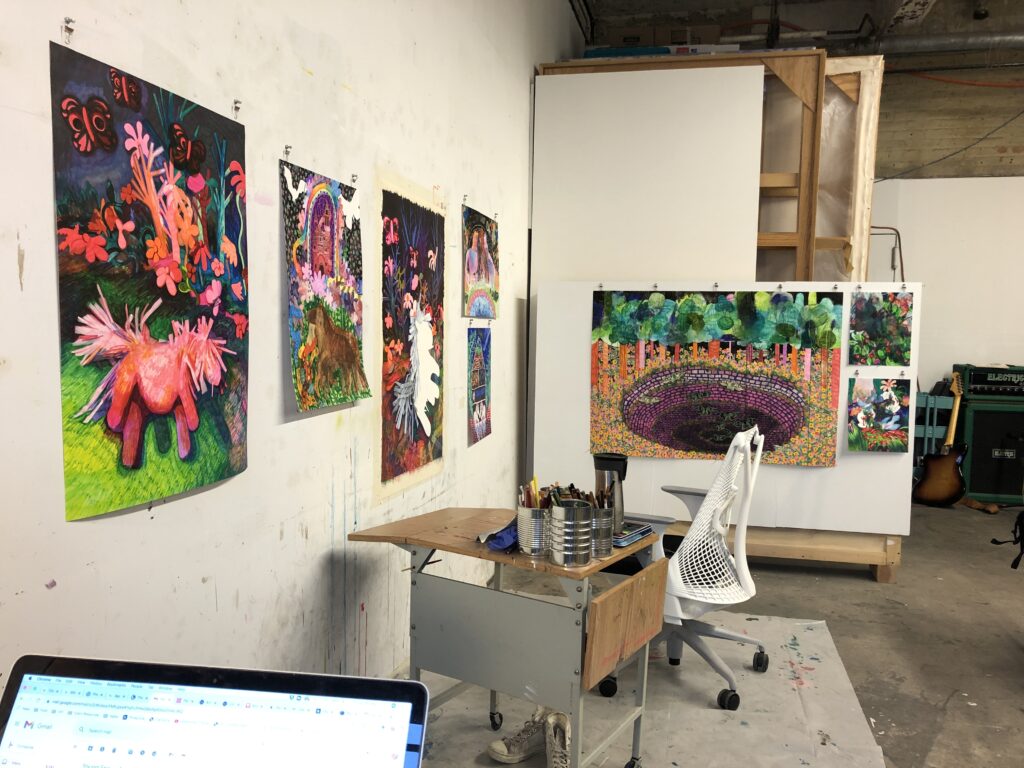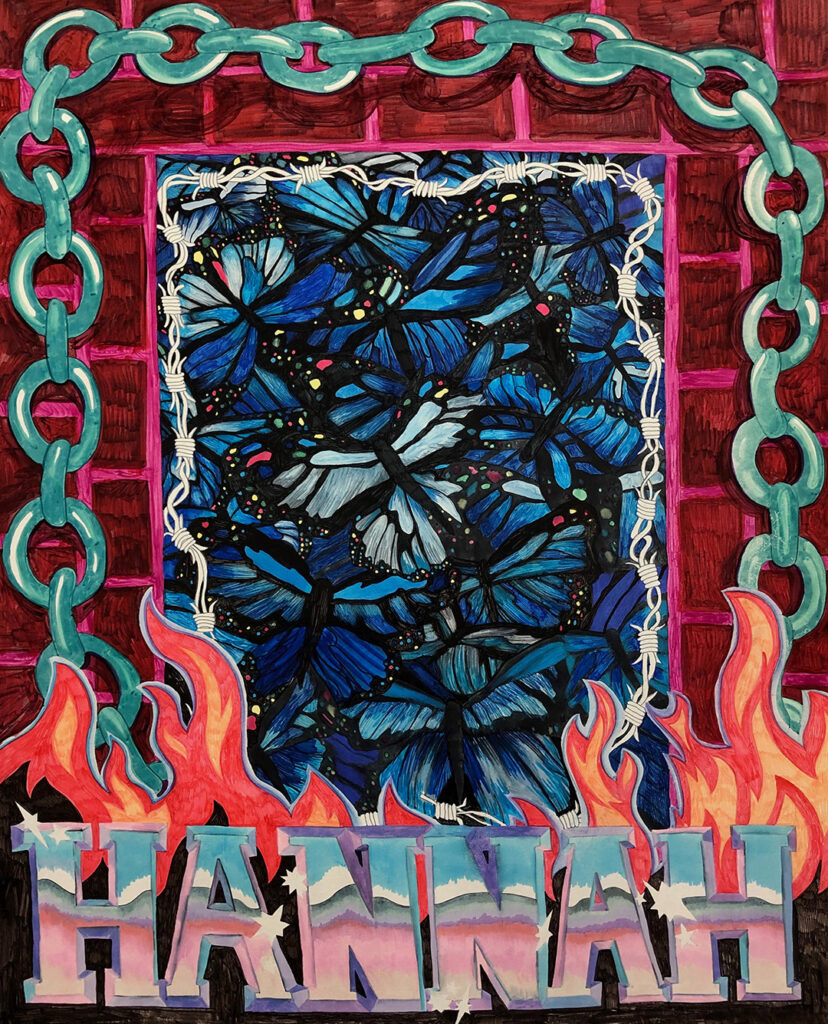Blue Wash Interviews is where we introduce you to our artists and their vision. Why do they do what they do? What inspires them? What does the future of art look like, according to them?
Hannah Antalek is a Brooklyn-based artist exploring her identity and the outside world through a variety of creative projects. In this interview, she shares her story with Blue Wash.

Tell us about yourself!
H: I live in Brooklyn. Right now I’m here at my studio. I moved here after graduation from Rhode Island School of Design where I studied painting. And before that I was living in upstate New York, in a town called Saratoga Springs. Since moving to Brooklyn, I’ve continued working on my painting and drawing practice, and having a bunch of odd jobs to complement that.
When did you first know you wanted to be an artist?
H: I think I always knew. There was never a point in my life when I considered doing anything else. My mom is a writer, so she was always supportive of having a creative lifestyle. My dad is in finance, but he’s always been in support of me having a creative career. They both invested in art classes for me when I was younger and made sure I had all the resources I needed – figuratively and literally.
Can you tell us about Rhode Island and your studies there?
H: The Rhode Island School of Design is what brings many artists to Rhode Island. A lot of incredible creative people studied there. I thought it was such a nice place to go to school! Rhode Island is really small, and the school is in Providence, which is definitely a more urban part of the otherwise pretty rural state. For me, it was a great place to study compared to New York. I felt like I had a chance to chill out there. Providence has a few galleries and one museum connected to the school, but otherwise it’s a place where I could enjoy the time spent in my studio without any distractions.
Your recent work has been inspired by the NYC scene during the COVID-19 pandemic. How has the pandemic influenced your creativity?
H: The pandemic was a way for me to get creative. I lost my job due to the restrictions, so I was able to work at my studio full time for 8 months. I’d never had such an opportunity before. I had time to play around with different types of work and think about what I wanted to create.
During that time, my work became very autobiographical. I was experiencing many conflicting emotions. I was thrilled to not have a job and be at my studio all the time, but this was all happening in the middle of a terrible pandemic that was killing thousands of people. It inspired a new avenue in my work.
You say that your works explore anxiety and fatalistic thought. Why are you interested in these topics?
H: It was just top of mind during the pandemic for everyone. And I’m generally an anxious person. I think it was kind of natural that these themes came into my work. Art became a way for me to process these emotions. Instead of pushing them out of my head, I started acknowledging them and trying to work through them.
Is it easy for you to switch these emotions off after the artwork is finished? Or do they linger in your head?
H: I think they always linger because anxiety is always at the back of my head. But I definitely get a release from creating my works in response to these feelings.
Even the process of sitting and drawing something very meticulous, like thousands of little flowers, gets me out of my thoughts. It transports me into a different space.
What inspires you?
H: I get a lot of my inspiration from books. I love to read science fiction – this is probably not surprising. And lately, I’ve been really interested in apocalyptic predictions and weird conspiracy theories, especially those from medieval manuscripts. They feel very relevant now, and find it interesting to see how these anxieties have a historical background.
Can you give us a book recommendation?
H: I just finished “Apocalypse Illuminated”. It’s a big book that compiles a bunch of apocalyptic manuscripts from the Middle Ages, a lot of which were based on the Book of Revelation. There are so many of them, which is crazy! We have a library here in New York that has special collections of original manuscripts from that era called the Morgan Library.. I’m so excited to see them in person as soon as the restrictions are lifted!
It’s fascinating to see how different artists dealt with the idea of the end of the world throughout history.
Are there any artists who inspire you?
H: So many! I have lots of friends that are doing amazing things, and I really love their works! For instance, my friends Zachary Ochoa and Ray Hwang – their practices really inspire me. My friend Nicole Dyre has fantastic art as well, and so does my other friend Michael MacDonald. There are just so many people I look up to!
My current job is working at a gallery as an artist liaison. So, I constantly meet new artists whose works inspire me.
What is something you cannot feel creative without?
H: Colour! It’s just so hard for me to think in black and white. Even when I’m doing a sketch before a painting, I can’t wait for it to be over! I find it uninspiring to see graphite on paper and want to start adding colour immediately. Sometimes I even rush the drawing part, because I want to get to the colouring part sooner.

You portray a lot of animals in your works. What is the role of animals in your life and why do you use them as characters rather than people?
H: I think I just like animals more than people, at least most of the time. And I think that animals have a lot of symbolism in them. It’s easy to create different allegories and narratives using animals. As soon as you start using people in your art, it becomes specific. But animals have a way of acting as symbols.
Your work Crushed has a lot of layers and meanings. Tell us more about it!
H: I tried to make the story ambiguous in Crushed. It has some scary things about it, but also some sexy things. For example, the cherries and the red colours can be seen as sweet but also sinister.
Rather than thinking of a cohesive narrative, I wanted to combine metaphors and symbols to create a disorienting space. This is the form that my anxiety takes most of the time.

Another one of your works. Firewall, features a big writing of your name in a fire frame. Is it a self portrait?
H: I keep coming back to butterflies in my work. I love that there are many different ways to read them. They are often seen as cute and girly, but they also symbolize metamorphosis. Butterflies change form so dramatically from caterpillars to butterflies! And they are also part of many religious narratives, where the butterfly is seen as a Christ-like figure
The butterflies in Firewall are sensitive, but they are surrounded by flames, chains, and brick walls. And I often feel like a sensitive butterfly putting this firewall around myself. So it’s a symbolic self-portrait of a kind.

What would you be doing in a parallel universe where you’re not an artist?
H: This question scares me! I can’t even think of what that would be. Maybe I would be a butterfly. I definitely would not be a person if I wasn’t an artist.
Can you tell us more about the New York City Crit Club?
H: It started out as a really small group led by Hilary Doyle (and later, co-director Catherine Haggarty)where a bunch of artists would get together and talk about their work. We would take turns presenting our works and have discussions about them. Over the years the club has grown into a much larger programme with multiple discipline-specific classes.
Are there any art mediums that you’d like to try?
H: That’s been at the top of my mind recently! I’ve been wanting to try ceramics. I’ve never done it before, except maybe for a summer camp programme when I was super young. I want to try it now when I’m in my full artistic capacity.
For a lot of my drawings, I make a little papier-mâché diorama first. It’s kind of time-consuming, and papier-mâché has its own shelf life. So I think it’d be really nice to try ceramics instead. I could make something I’d use as a drawing reference, but then it also would be an art object by itself.
What are your next art-related goals?
H: I just want to spend more time in my studio. Being an artist liaison is a full-time job, which is something new for me. I’ve always had part-time and freelance jobs before. So it’s been a struggle for me to figure out the balance between my work life and studio life.
I’ve also been trying to translate some of my drawings into bigger paintings. It’s been mixed results so far, but I’m excited!
What do you think is the future of art?
H: I hope that the art world will be more democratic and not solely controlled by big galleries. I think it will be more about supporting artists than just funneling money. The pandemic has pushed the art world in the right direction in this sense because many smaller artists and organisations have learned to innovate and find ways to get their work out there.
I think that platforms like Blue Wash are making it possible to have a more diverse playing field for artists. And I do hope that there’s more of that in the future. I want to see more artists with power that’s not left up to galleries and art advisers.
Do you feel like you, as an artist, have that power right now?
H: I feel like I have the power within certain circles. I’ve been lucky to have opportunities to curate exhibitions of my friends and have myself be included in exhibitions. So, I feel powerful in that way, but maybe not in the greater gallery scene.


 News
News